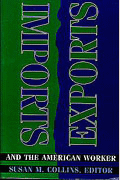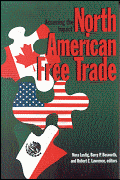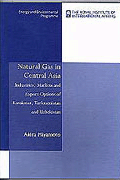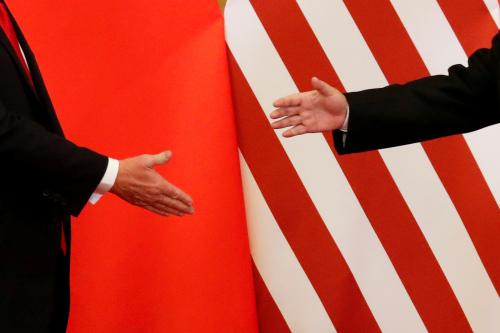What is the effect of the new U.S.-China trade war on the two economies and where does this all end? David Dollar explains in a piece that originally appeared in The Hill.
The Trump administration followed through today on a 25-percent tax on imports of $34 billion of goods from China, including machinery and components like semiconductors. A tax on another $16 billion of goods is in the works.
China immediately retaliated with a 25-percent tariff on imports of soy beans, other agricultural products and automobiles. These moves come on top of tariffs already imposed on steel, aluminum, washing machines and solar panels.
The aggregate amount of trade affected is moderate relative to the U.S. and Chinese economies, but for the U.S., this is the most extensive import protection since the disastrous Smoot-Hawley tariffs in the 1930s. President Trump has threatened a 10-percent tax on a further $200 billion of imports from China. What is the effect on the two economies and where does this all end?
China is in a fairly good position to weather this storm. Its economy is less dependent on exports in general, and exports to the U.S. in particular, than just a decade earlier. The value added in its exports to the U.S. is less than 3 percent of its economy.
This reflects the fact that China is at the end of many global value chains, which include inputs from the U.S., Japan, South Korea and Taiwan. Some of the pain from the U.S. tariffs will hit these other economies, not China. Still, the trade war comes at a bad moment in China’s cycle.
The authorities have been tightening financial conditions and trying to rein in financial risks, so that the economy is slowing, even before it takes a hit from trade. The Shanghai stock market is in bear territory, down 23 percent from a recent high in January. This reflects a combination of the deleveraging campaign and worries about trade.
In the past two months, the Chinese currency has depreciated 4.3 percent against the dollar. This is a natural market reaction to the U.S. protection. Over the same period, the dollar has appreciated about 5 percent against a basket of major currencies.
This is one of the ironies of the U.S. trying to use trade taxes. They create uncertainty in the world and one result is that capital flows out of other economies to the U.S. In the short run, this raises the value of the dollar and largely undoes the protection.
Historically, when the U.S. introduces protection, it has typically not led to an improvement in the trade balance, rather the opposite. In the case of U.S.-China trade, the 25-percent tax means that about $50 billion of imports will be more expensive, and the U.S. is likely to import less.
But the other $500 billion that the U.S. imports will be modestly cheaper because of depreciation and the U.S. will import more. History suggests that the net effect on the trade balance will be minor. This is one reason that the direct effect on the Chinese economy is likely to be minor.
Most forecasters still have Chinese growth at 6.5 percent or higher for 2018. However, if the trade war continues to escalate, there is a risk of capital outflow from China precipitating a financial crisis. China’s leaders are committed to retaliating in response to each measure, but they have been careful not to escalate the tensions.
What about the effect on the U.S. economy? The U.S. economy is humming along because of fiscal stimulus from tax cuts plus expenditure increases. Net job gains in June were above 200,000, the pattern of recent months.
In general, the trade war will destroy some jobs in export sectors and create some jobs in import-competing ones. This is a bad tradeoff because export jobs are generally higher productivity and pay.
The job churning is also disruptive — the lost jobs are likely to be in agricultural states and southern states with auto plants, whereas job gains are probably elsewhere. The Trump White House is betting that, given the overall strength of the economy, some localized pain will be tolerable and the get-tough policy toward China will be a political winner for the midterms.
What then is the off-ramp? The trade conflict is unlikely to de-escalate during 2018. If the U.S. identifies further imports to be taxed, there will be a 60-day comment period, which provides one window for negotiation. China, however, is unlikely to change its basic offer: It is willing to buy more agricultural products, energy and high-tech manufacturing if the U.S. is willing to sell.
It is gradually opening up more sectors of its economy, such as automobiles and financial services. If the U.S. persists in the trade war, then American firms are likely to be shut out as China opens up. By 2019, the negative effects of the protection are likely to be stronger while the influence of the fiscal stimulus wanes.
Do not be surprised if in 2019 the U.S. takes the offer that has been on the table, dressing it up a bit in order to declare victory.








Commentary
The future of the U.S.-China trade war
July 9, 2018